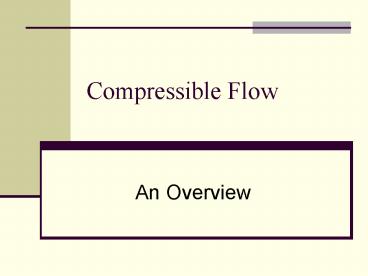Compressible Flow - PowerPoint PPT Presentation
1 / 34
Title:
Compressible Flow
Description:
Speed of Sound Equation. Ideal Gas Equation. This is obviously an introduction to this topic. ... Property Relationships. MSH 6.23. MSH 6.24 ... – PowerPoint PPT presentation
Number of Views:461
Avg rating:3.0/5.0
Title: Compressible Flow
1
Compressible Flow
- An Overview
2
Restricting to 3 Expansions
- Isentropic (constant entropy)
- Well-designed venturi meters come close
- Adiabatic (Q 0)
- Perfect insulation
- Very short time frames (no time for energy loss
by conduction) - Isothermal (no temperature change)
- Must add energy to maintain temperature when a
gas expands - For Ma lt 0.3, same results as adiabatic
3
and with 7 assumptions
- Steady flow (no time variations)
- 1-d flow
- Assume a1 (avg. velocity local velocity, flat
profile) - Only friction is skin friction, hf hfs
- No shaft work (no pump or turbine)
- Gravitational effects negligible (?z 0)
- Ideal Gas (constant Cp, Cv)
4
can describe a compressible flow with just 5
equations.
- Continuity Equation (mass balance)
- Total Energy Balance (accounts for Q)
- Mechanical Energy Balance (pressure, kinetic
energy, and friction terms remain) - Speed of Sound Equation
- Ideal Gas Equation
5
This is obviously an introduction to this topic.
6
Equation of Continuity, p. 1
The mass flow rate is constant.
7
Equation of Continuity, p. 2
We will write these equations in differential
form. Taking a natural log may assist
Differentiating
MSH 6.2
8
Total Energy Balance, p.1
MSH 6.3
energy crossing boundary per unit mass
enthalpy change per unit mass
kinetic energy change per unit mass
9
Total Energy Balance, p.2
In differential form
MSH 6.4
enthalpy change per unit mass
energy crossing boundary per unit mass
kinetic energy change per unit mass
10
Mechanical Energy Balance, p. 1
Asp. 5
Asp. 6
Asp. 3
Asp. 4
11
Mechanical Energy Balance, p. 2
In differential form
MSH 6.6
12
Mechanical Energy Balance, p. 3
Relating hfs to friction factor
MSH 5.7
In differential form
13
Mechanical Energy Balance, p. 4
Substituting
MSH 6.8
skin friction
pressure drop
kinetic energy
14
Speed of Sound, a p. 1
Mach Number Definition
actual gas velocity
speed of sound
Calculating Speed of Sound
ltlt constant entropy, s
15
Speed of Sound, a p. 2
For an Ideal Gas
MSH 6.17
where
16
Nomenclature Asterisk Condition
- The conditions (temperature, pressure, etc.)
that create a flow at Ma1 are often indicated by
means of an asterisk (T, p, etc.)
17
Definition Stagnation Temperature
- Q If a moving fluid is quickly brought to a
stop, and all of the kinetic energy that is
released by the fluid as it slows is used to warm
the fluid, how hot will the fluid get? - A The Stagnation Temperature.
18
Equation for Stagnation Temperature
- The equation for stagnation temperature can be
derived from the total energy balance (MSB p.
132).
MSH 6.20
19
ISENTROPIC EXPANSION
20
Eqns for Isentropic Expansion, p. 1
- Property Relationships
MSH 6.23
MSH 6.24
Subscript o refers to the reservoir or
entrance flow conditions.
21
Eqns for Isentropic Expansion, p. 2
- Velocity in Nozzle
- Isentropic nozzles are designed to minimize
friction - assume hfs 0
MSH 6.25 simplified MEB
22
Eqns for Isentropic Expansion, p. 3
- Mach Number Squared
MSH 6.27
23
Eqns for Isentropic Expansion, p. 4
- Critical Pressure Ratio, rc
- The critical pressure ratio is the ratio that
generates a flow of Ma 1 for a given reservoir
condition (po).
MSH 6.29
24
Eqns for Isentropic Expansion, p. 5
- Mass Flux (Mass Velocity), G, at a point of known
pressure, p.
Definition of mass velocity, G
MSH 6.30
25
Eqns for Isentropic Expansion, p. 6
- Relationship between u and S
MSH 6.33
Ma 1
26
ADIABATIC EXPANSION
27
Eqns for Adiabatic Expansion, p. 1
- Adiabatic (Q0)
- No energy transfer to or from surroundings.
- Flow cannot cross sonic threshold (Ma 1)
- If Ma gt 1, then flow can decrease only to Ma 1
- If Ma lt 1, then flow can increase only to Ma 1
28
Eqns for Adiabatic Expansion, p. 2
- Property Relationships
MSH 6.39
MSH 6.43
MSH 6.44
29
Eqns for Adiabatic Expansion, p. 3
- Determining an Average Friction Factor
MSH 6.38
30
Eqns for Adiabatic Expansion, p. 4
- Determining Maximum Conduit Length
- (Occurs when flow reaches Ma 1 at point b.)
MSH 6.45 (unsimplified)
31
Eqns for Adiabatic Expansion, p. 5
- Mass Velocity, G
MSH 6.46
32
ISOTHERMAL EXPANSION
33
Eqns for Isothermal Expansion, p. 1
- Property Relationship
Pressure/Velocity Equation
MSH 6.49 (subsonic)
Can substitute pressure ratio
34
Eqns for Isothermal Expansion, p. 2
- Heat Transfer Equation
MSH 6.50, 51 (subsonic)































